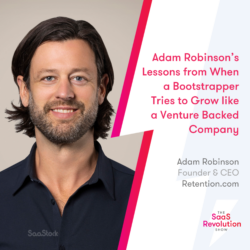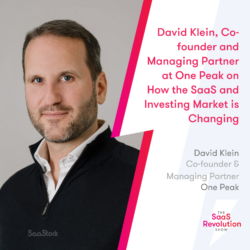The world of SaaS is constantly changing, so we want to know: what are the key SaaS trends we should expect to see in 2020?
SaaStock brings together the brightest minds in SaaS – so where better to pick their brains about the SaaS trends we should know about for the new year. We asked 11 experts – from founders, CEOs and senior marketers, to investors and VCs – and came up with this list of the top ten SaaS trends for 2020.
1) Product-led growth
“There’s a lot of SaaS trends I’m picking up on here at SaaStock. One of the biggest ones is around product-led growth, and the importance of product management and customer success teams having a tighter alignment.”
– Lauren Olerich, Senior Director, EMEA Marketing, Gainsight
In 2019 we’ve been hearing more about product-led growth – but 2020 might just be the year it heads centre-stage. While most companies focus their marketing and sales efforts on external acquisition channels to drive demand, in some cases your product can be the driver for your growth.
One of the core tenets of product-led growth is the idea of tracking and measuring product usage – and using that data across your whole business to drive growth.
For example, Sales teams can use product data to identify good-fit customers who are an opportunity to upsell to; Customer Success teams can use it to understand the health of their customers, and to identify low-usage customers who may be at-risk of churn; and Engineering teams can use it to better align their roadmap decisions with the features and functionality that provide most value to the customer.
“If you think of product-led [growth], think of companies like Atlassian and Netflix, that are driving their growth through the product itself. It’s less driven, though it’s still supported by sales and marketing, but it’s really driven by the product. The product becomes a source of data that’s used in the different parts of the organization… So the product becomes the base of the whole experience instead of just the thing you sell.”
– Eric Boduch, Co-founder, Pendo
2) Product positioning
The Martech 5000 supergraphic is one of the most widely recognised graphic in SaaS. It crops up in slides at dozens of conferences because it’s so perfect for illustrating how ubiquitous SaaS – and in particular marketing technology – has become.
So one of the biggest – and arguably most important – trends we’re expecting to see in 2020 is differentiation. Whether that’s startups focusing more closely on specific verticals, geographies or sub-industry, it’s clear that you can no longer hope to build a SaaS company that appeals to everyone. Going niche may be the best strategy for emerging startups in 2020.
“SaaS has become so so big now, and so competitive… so the trends you see are more about how do you differentiate… Every single thing, every single industry or sub-industry can create a massive unicorn SaaS company at this point. SaaS has really unlocked the potential for business software to be a huge global market that every SMB in the world uses.”
– Nick Franklin, CEO, ChartMogul
3) Prioritising profitability and sustainable growth
“I think the biggest trends we’re currently seeing is that while growth remains important (especially at scale) it also gets more and more important to look at your metrics and remain profitable as we grow. Both from a growth margin but also from a customer acquisition perspective.”
– Hanno Renner, CEO & Co-Founder, Personio
For too long SaaS founders have fallen into the trap of chasing growth at all costs. They spend big to acquire new customers, in the hope that acquiring ever-higher customer numbers will propel their growth that bit further.
But increasingly we’re seeing a shift towards prioritising sustainable growth. Because building and growing a SaaS company isn’t a sprint – it’s a marathon. And to grow sustainably you can’t just look to bring in new customers to fill your revenue gaps. You need to build a product and business that’s able to retain customers too.
That could mean investing in customer support and customer success teams, or it could mean taking an approach to product development based on current usage data, basing future product releases on customer needs. Either way, in 2020 we’re expecting to see a mindset shift, away from growth at all costs, and towards sustainable growth.
4) Measure what matters
“So what I’m noticing in the SaaS industry today is that companies are being very specific, but also very keen to measure their KPIs, as well as be able to track them in a much more meaningful way – rather than just your standard LTV, CAC and ARR. We’re actually getting down to a lot more detailed metrics, and into 2020 I see that more companies are getting more tools that are sophisticated and allowing them to better track and measure their growth at a much more incremental pace.”
– Eric Chan, Head of Partnerships, Chargebee
As Eric said, there are a handful of SaaS metrics that you need to track from day one: customer lifetime value (LTV or CLTV); customer acquisition cost (CAC); and annual recurring revenue (ARR). These help you understand the big picture: your revenue health.
But there are lots of other metrics that can give you more detailed information into the health of your SaaS business. From tracking customer churn to measuring customer acquisition by channel, going beyond the surface-level metrics can provide more detailed insights that will help you grow your SaaS.
5) Podcasts
Marketers are always looking for new channels to reach their audience, and podcasts are continuing to grow in popularity. With that surge in popularity looking to carry on in 2020, SaaS companies should consider the following:
- Stand-out from the crowd – thinking of starting a podcast? Get your inspiration from outside of the SaaS space, to avoid creating something that sounds just like your competitor’s podcast.
- Audience building – you want subscribers and repeat audiences, not just one-off listeners. How will you keep people coming back for more?
- Brand alignment – you should be sure that your podcast aligns with your brand – but be careful each episode doesn’t turn into a sales pitch.
6) AI
“We’re really excited about what customers are doing with AI right now. We’re seeing some incredible innovation across all industries right now, and consumer products, the medical field, and retail… It’s a really exciting trend.”
– Matt Rogers, Head of SaaS Initiative, Global Technology Partners, Google
There’s been a lot of hype around artificial intelligence over the past couple of years, and we’re expecting 2020 to be the year we finally start to see the power of AI.
From automation to personalisation, we’re expecting to see more SaaS companies offering product functionality powered by AI – as well as making use of artificial intelligence in their marketing and sales processes.
“The trends I’m seeing this year is our customers want to be connected to their data in a whole new way. The partners we’re working with, the applications we’re working with, are really using much more intelligent AI, analytics to really help customers connect and have a real customer experience.”
– Chris Hemingway, ISV Regional VP, Salesforce AppExchange
7) Customer-centricity
“I’m seeing a lot of businesses that truly want to put their customers at the centre of their business, and that’s something we’re really excited about.”
– Lauren Olerich, Senior Director, EMEA Marketing, Gainsight
I hope this isn’t just a passing trend, but more something people are consciously building into the core of their companies. In SaaS, perhaps more than any other industry, customer retention is key to growth and profitability.
One of the most common reasons startups fail is that their customer acquisition costs outweigh their customer lifetime value – meaning it costs them more to acquire each customer than that customer generates in revenue. So retaining customers for two, three, four years gives you time to recoup that initial acquisition cost, and grow that lifetime value:
“The investment in adoption and growth of your customers. So once you acquire them that’s just the first step. How you think about ensuring their success, ongoing training, onboarding of new customers… the whole customer experience from end to end is more important in SaaS than any other industry.”
– Sydney Sloan, CMO, SalesLoft
8) Hypergrowth
With the right product offering in the right market, time after time we see companies really take off. And that trend doesn’t look like it’s going to slow down any time soon:
“One of the things that have been really exciting in the last 2-3 years is that companies that do well can grow much faster than before, both in terms of going into new verticals as well as internationalising. In parts because of the availability of APIs and the modularity of software, and in part because of the availability of capital. And I see that continuing into 2020.”
– Michiel Kotting, Partner, Northzone
We’ve seen most regions globally establishing a healthy venture capital ecosystem – check out our Latin America, Australasia and Asia investor lists. Getting access to capital at the right time is essential for startups looking to accelerate into hypergrowth, enabling them to invest more heavily in product development, team and resourcing, and stepping up marketing initiatives.
9) Buyer behaviour
“This advent of peer reviews and how people are actually buying software now. Where it’s not just hearing from your friend, but actually going to peer review sites like G2 and TrustRadius. I’m seeing that as being a clear differentiator in how we’re selling our SaaS products.”
– Sydney Sloan, CMO, SalesLoft
Founders and marketers alike have long known the value of social proof when it comes to selling your product or service. But the rise of peer review sites like G2 or Capterra have put user reviews at the heart of the software buying process.
Whereas previously you might have been limited to asking people within your network for their opinions on this CRM vs that one, now you can search dozens of reviews in a matter of seconds. Great if you’re a customer. And great if you’re a marketer – as long as your customers are leaving glowing reviews about your product.
So for 2020 it’s likely that we’ll see more marketing teams doubling-down on review sites as a customer acquisition channel.
10) Navigating the overwhelm
“The most noticeable trends I’m seeing in the SaaS industry is just continuing this uber-trend of overwhelm. Of more apps, more channels, more content, more messages, with the result of everyone’s just getting overwhelmed… So how do you navigate all this overwhelm is probably the number one key towards companies growing their revenue – that ability to focus”
– Aaron Ross, Co-CEO, Predictable Revenue
Sorry to end on a down note, but this is definitely something you should be thinking about. Take a look at your phone: how many apps are there, sending you countless notifications every day? And then your laptop. And all the messaging tools, fighting for your attention.
Your SaaS product is just another thing fighting for your customer’s attention. How will you stand out, make your product essential – and then help your customer focus on being successful with your product, without being distracted by one of their other apps or devices?





